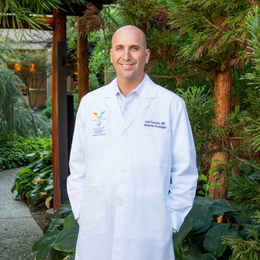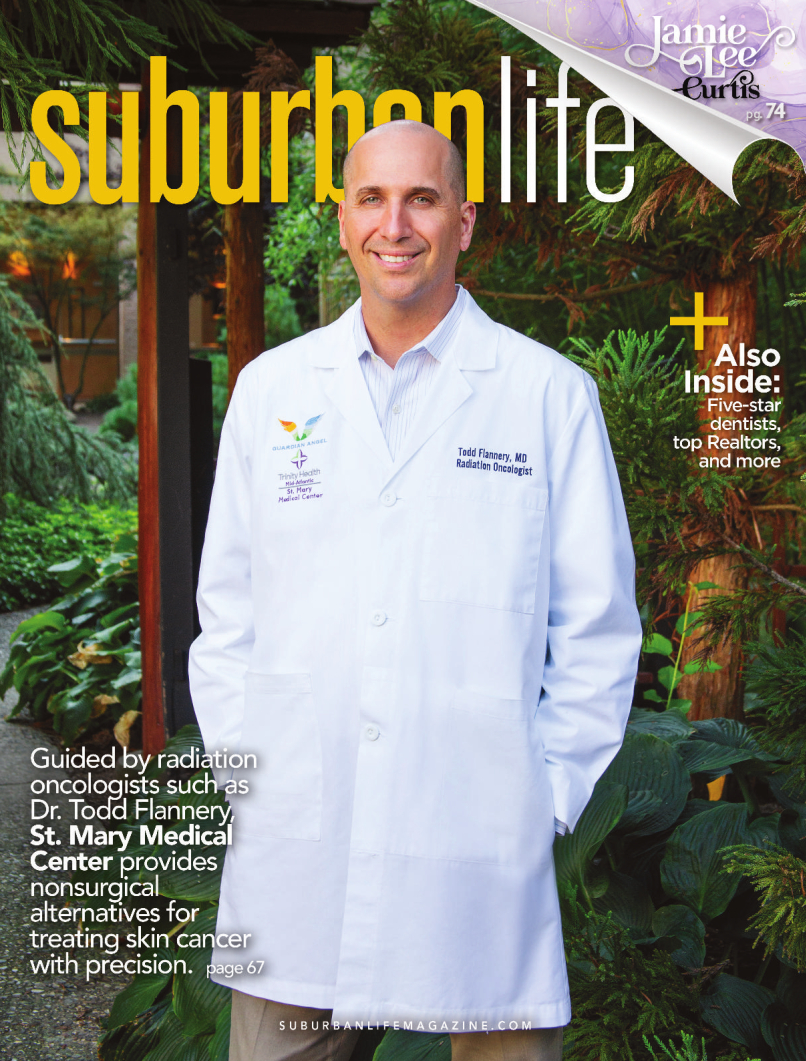
X Marks the Spot
Guided by radiation oncologists such as Dr. Todd Flannery, St. Mary Medical Center provides nonsurgical alternatives for treating skin cancer with precision.
Joyce Manser has wonderfully fond memories of the summers she spent with her grandmother in Wildwood, New Jersey. A self-described “sun worshipper,” Manser adored the sand and surf, and the feeling of sunshine on her fair skin.
Now retired, Manser was reminded of the blissful summers of her youth in February 2022, after a routine screening at the dermatologist’s office revealed a basal cell carcinoma—one of the most common forms of skin cancer—on the tip of her nose. The dermatologist discussed Mohs surgery, a specialized procedure in which a surgeon excises the affected tissue one layer at a time, and then examines each layer under a microscope until no evidence of cancer remains.
Manser knew all about Mohs surgery, as she had opted for the procedure to remove a prior skin lesion on her ankle, but she did not want to risk any scarring or disfigurement on her face. Shortly after receiving the diagnosis, she spoke with a friend who chose a nonsurgical alternative to cure the skin cancer on her face: radiation therapy.
Manser immediately began researching the radiation-therapy options near her home in the Lawrenceville area. She also asked her dermatologist to refer a skilled clinician. That’s how Manser came to know Todd Flannery, M.D., a radiation oncologist who treats patients at St. Mary Medical Center across the river in Bucks County.
“During my first visit with Dr. Flannery, he told me everything that was going to happen, including all the pros and cons,” Manser recalls. “There are a few different options with radiation, but because of where my cancer was located, I had to have something called external electron beam radiation. I had to get 17 treatments in total, the first of which was on March 29, 2022.”
The number of visits, Manser adds, was the only drawback of the treatment. The procedure itself was “really no trouble,” she says. How it worked: After a customized mold was placed over her face, with only the nose exposed, she would lie down on the treatment table while Dr. Flannery oversaw the team—including radiation therapists, dosimetrists, and an on-staff physicist—to attack the lesion with precisely targeted radiation.
“With each treatment, it was over by the time I counted to 20 or 25,” Manser recalls. “At the end of the 17 treatments, it was like having a bad sunburn on my nose, but it was never too uncomfortable. It started getting better within two weeks.”
At St. Mary Medical Center, Dr. Flannery and two of his fellow radiation oncologists—Robert Cardinale, M.D., and Hiral Fontanilla, M.D.—deliver highly precise radiation therapy to treat cancers throughout the body. While St. Mary Medical Center currently uses the Varian TrueBeam™ radiotherapy system, Dr. Flannery says the hospital will soon be adding the Varian Halcyon® radiotherapy system as yet another sign of its devotion to providing comprehensive cancer care.
Dr. Flannery describes radiation therapy for skin cancer as safe and effective, with “almost zero” risk of the radiation causing another cancer. That said, he does not recommend radiation for every patient; some will be better candidates for Mohs surgery, which remains the standard of care.
“Radiation can be a good option for patients who have skin cancer near the eye, on the nose, or the ear,” he says. “Some patients choose radiation for cosmetic reasons, as there is no cutting or scarring. It’s also a good option for patients who are on blood thinners, or if the cancer has spread; this invisible beam of energy can penetrate underneath the skin and into the lymph nodes, if needed.”
Manser returned to Dr. Flannery again in August 2022, to treat a basal cell carcinoma on her ear, and again in May 2023, to treat a squamous cell carcinoma on the back of her hand. For the cancer on her hand, Dr. Flannery prescribed high-dose-rate brachytherapy, which delivers a more potent dose of radiation directly to the lesion over a shorter duration—just seven days in Manser’s case.
Manser is happy to be cancer-free—and scar-free—after her trio of recent treatments. If she ever does require further treatment, she knows exactly who to call.
“I can’t speak kindly enough about Dr. Flannery,” she says. “I was happy to drive 20 to 30 minutes more to get to Dr. Flannery; he and the entire staff at St. Mary were just wonderful. It was a nice experience for dealing with a not-so-nice issue.”
St. Mary Medical Center
1201 Langhorne-Newtown Road
Langhorne, PA 19047
(215) 710-2000
trinityhealthma.org
1201 Langhorne-Newtown Road
Langhorne, PA 19047
(215) 710-2000
trinityhealthma.org
Photo by Alison Dunlap
Published (and copyrighted) in Suburban Life, September 2023.



